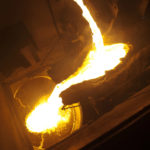Properties That Can be Affected by Heat Treatment
When service conditions demand higher hardness areas on components to resist wear, abrasion, erosion, indentation or increase fatigue resistance, various treatments can be specified.
Surface Hardening
Case carburisation followed by quench hardening is a process which is well documented and has occupied a leadership role in surface hardening technology for decades. It is still the major surface hardening treatment with wide application in the gear industry and automotive components manufacturing.
Nitriding
Nitriding and various related processes are lower temperature solid state reactions which as a consequence are very valuable for surface hardening items requiring minimal distortion during processing.
By using special steel grades the surface hardness of nitrided components can be very high, say 1100 Vickers compared to 750-800 Vickers for a carburised and quenched structure.
It is important to note that for nitriding to be successful, the steel used should be hardened and tempered or the components should be rough machined then hardened and tempered, usually to a hardness range of HRc 30 – HRc 35. Nitriding must be carded out on a correct microstructure of tempered martensite to minimise the occurrence of spalling.
Read more: Surface Hardening






